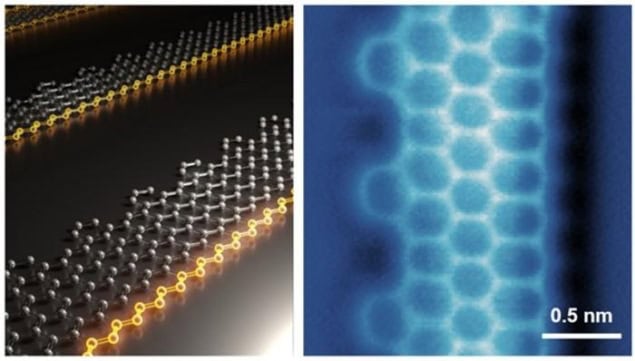A new graphene nanostructure could become the basis for the first ferromagnets made purely from carbon. Known as an asymmetric or “Janus” graphene nanoribbon after the two-faced god in Roman mythology, the opposite edges of this structure have different properties, with one edge taking a zigzag form. Lu Jiong , a researcher at the National University of Singapore (NUS) who co-led the effort to make the structure, explains that it is this zigzag edge that gives rise to the ferromagnetic state, making the structure the first of its kind.
“The work is the first demonstration of the concept of a Janus graphene nanoribbon (JGNR) strand featuring a single ferromagnetic zigzag edge,” Lu says.
Graphene nanostructures with zigzag-shaped edges show much promise for technological applications thanks to their electronic and magnetic properties. Zigzag GNRs (ZGNRs) are especially appealing because the behaviour of their electrons can be tuned from metal-like to semiconducting by adjusting the length or width of the ribbons; modifying the structure of their edges; or doping them with non-carbon atoms. The same techniques can also be used to make such materials magnetic. This versatility means they can be used as building blocks for numerous applications, including quantum and spintronics technologies.
Previously, only two types of symmetric ZGNRs had been synthesized via on-surface chemistry: 6-ZGNR and nitrogen-doped 6-ZGNR, where the “6” refers to the number of carbon rows across the nanoribbon’s width. In the latest work, Lu and co-team leaders Hiroshi Sakaguchi of the University of Kyoto, Japan and Steven Louie at the University of California, Berkeley, US sought to expand this list.
“It has been a long-sought goal to make other forms of zigzag-edge related GNRs with exotic quantum magnetic states for studying new science and developing new applications,” says team member Song Shaotang, the first author of a paper in Nature about the research.
ZGNRs with asymmetric edges
Building on topological classification theory developed in previous research by Louie and colleagues, theorists in the Singapore-Japan-US collaboration predicted that it should be possible to tune the magnetic properties of these structures by making ZGNRs with asymmetric edges. “These nanoribbons have one pristine zigzag edge and another edge decorated with a pattern of topological defects spaced by a certain number m of missing motifs,” Louie explains. “Our experimental team members, using innovative z-shaped precursor molecules for synthesis, were able to make two kinds of such ZGNRs. Both of these have one edge that supports a benzene motif array with a spacing of m = 2 missing benzene rings in between. The other edge is a conventional zigzag edge.”
Crucially, the theory predicted that the magnetic behaviour – ranging from antiferromagnetism to ferrimagnetism to ferromagnetism – of these JGNRs could be controlled by varying the value of m. In particular, says Louie, the configuration of m = 2 is predicted to show ferromagnetism – that is, all electron spins aligned in the same direction – concentrated entirely on the pristine zigzag edge. This behaviour contrasts sharply with that of symmetric ZGNRs, where spin polarization occurs on both edges and the aligned edge spins are antiferromagnetically coupled across the width of the ribbon.
Precursor design and synthesis
To validate these theoretical predictions, the team synthesized JGNRs on a surface. They then used advanced scanning tunnelling microscope (STM) and atomic force microscope (AFM) measurements to visualize the materials’ exact real-space chemical structure. These measurements also revealed the emergence of exotic magnetic states in the JGNRs synthesized in Lu’s lab at the NUS.

In the past, Sakaguchi explains that GNRs were mainly synthesized using symmetric precursor chemical structures, largely because their asymmetric counterparts were so scarce. One of the challenges in this work, he notes, was to design asymmetric polymeric precursors that could undergo the essential fusion (dehydrogenation) process to form JGNRs. These molecules often orient randomly, so the researchers needed to use additional techniques to align them unidirectionally prior to the polymerization reaction. “Addressing this challenge in the future could allow us to produce JGNRs with a broader range of magnetic properties,” Sakaguchi says.
Towards carbon-based ferromagnets
According to Lu, the team’s research shows that JGNRs could become the first carbon-based spin transport channels to show ferromagnetism. They might even lead to the development of carbon-based ferromagnets, capping off a research effort that began in the 1980s.
However, Lu acknowledges that there is much work to do before these structures find real-world applications. For one, they are not currently very robust when exposed to air. “The next goal,” he says, “is to develop chemical modifications that will enhance the stability of these 1D structures so that they can survive under ambient conditions.”
A further goal, he continues, is to synthesize JGNRs with different values of m, as well as other classes of JGNRs with different types of defective edges. “We will also be exploring the 1D spin physics of these structures and [will] investigate their spin dynamics using techniques such as scanning tunnelling microscopy combined with electron spin resonance, paving the way for their potential applications in quantum technologies.”
The post Two-faced graphene nanoribbons could make the first purely carbon-based ferromagnets appeared first on Physics World.

